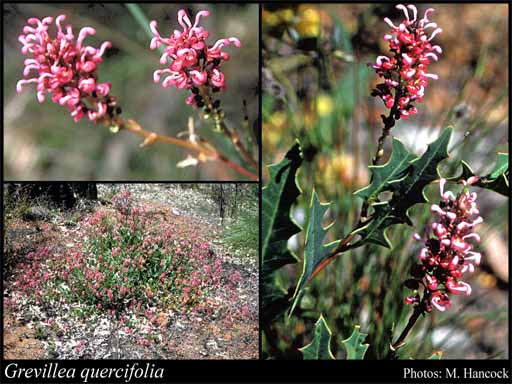- Reference
- Prodr. Suppl. 23 (1830)
- Conservation Code
- Not threatened
- Naturalised Status
- Native to Western Australia
- Name Status
- Current
Straggly to sprawling, lignotuberous shrub, 0.3-0.7 m high. Fl. pink/red/purple, Jul to Dec. Sand, loam, often with gravel, laterite.

Scientific Description
Shrubs, 0.3-0.6 m high; branchlets glabrous or hairy, not glaucous. Leaves alternate, 35-200 mm long, 10-45 mm wide, hairy or glabrous, on the abaxial surface, the hairs straight; lamina flat, widest around the middle, once divided, pinnately divided, deeply divided, the margins flat. Inflorescences axillary or terminal, pink; pedicels 4-6 mm long. Perianth 4-6 mm long; tepals all free after flower opens, glabrous; ovary glabrous, stipitate, the stipe 2-3 mm long; pistil 7-10 mm long, pink, pollen presenter lateral, style glabrous. Follicles glabrous or hairy, not viscid, dehiscent, 18-20 mm long. Flowers in September, October or November. Occurs in the South-west (SW) Botanical Province(s), in the Swan Coastal Plain (SWA), Jarrah Forest (JF) or Warren (WAR) IBRA subregion(s).
Distribution
- IBRA Regions
- Jarrah Forest, Swan Coastal Plain, Warren.
- IBRA Subregions
- Northern Jarrah Forest, Perth, Southern Jarrah Forest, Warren.
- IMCRA Regions
- Leeuwin-Naturaliste.
- Local Government Areas (LGAs)
- Albany, Armadale, Augusta Margaret River, Beverley, Boddington, Bridgetown-Greenbushes, Brookton, Busselton, Capel, Collie, Cranbrook, Dardanup, Denmark, Donnybrook-Balingup, Gosnells, Harvey, Kalamunda, Kojonup, Manjimup, Mundaring, Murray, Nannup, Plantagenet, Serpentine-Jarrahdale, Swan, Wandering, Waroona, West Arthur, Williams.